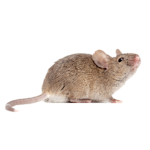Mice
Mus Musculus

What are mice?
The house mouse originated in the arid grasslands of Southeast Asia. Three subspecies similar in appearance are generally referred to under the name of one species, the Mus Musculus. Like their larger counterparts, rats, they are nocturnal creatures, feeding at night to avoid predation. Mice are timid, social, and territorial.
The most common house mouse observed in the US is an ancestor of the white mouse used for scientific experimentation. In its wild state, the house mouse is approximately 6.5 inches long, including the tail. When found indoors, it can be larger due the availability of better nutrition. These mice are usually yellowish-gray and sometimes streaked with black. Occasionally, the deer mouse, harvest mouse, and pocket mouse may invade buildings located near fields. They are commonly mistaken with house mice when this happens.
What is their behavior and habitat?
The behavior of mice is often hard to predict, which is true for all rodents. However, some generalizations can be made of mice living in and around buildings.
In urban areas, mice can spend their entire lives in buildings. When inside, mice can be found living in their nests, which are almost always close to a food source, in closets, walls, ceiling voids, large appliances, bureaus, the upholstery of furniture, behind or above the insulation in attics, and in basements. Suburban and rural areas may promote the same kind of complete indoor living as in the city, but mice can live outdoors among weeds and shrubbery, near building foundations, in storage sheds, garages, or in crawl spaces beneath structures.
Nests serve the purpose of providing warmth and protection for female mice when they give birth to their pups. Nests can be made from all sorts of materials including paper, insulation, the stuffing from furniture, or any soft material that can be chewed to bits for the purpose of building a soft bed. If mice nest outside, they will build their homes in ground burrows or among debris.
Once a nest is established and the population grows, territory becomes an important factor. The process of establishing territory is started when a dominant male in the population sets up an area to be controlled. Each territory has a distinct make-up comprised of a dominant male, one or more females, several weak males, and a number of young. When a young mouse leaves the territory, he must fight with the dominant male controlling another territory for control, or search for an unclaimed area to set up his own territory. This is how mouse infestations spread throughout a building.
The size of a territory depends on several different factors. These factors include the physical arrangement of the environment, availability of food, and the number of mice in the area. Generally, however, a mouse’s territory ranges from 10-30 feet. The more food available, the less territory a mouse is bound to have. This is also true of the number of mice occupying an area– the more mice, the less territory. Mice will not travel more than a few feet from their nest when food and other mice are plentiful.
Mice explore and re-explore their territories on a daily basis, becoming extremely familiar with the area. Every pathway to and from water and food becomes ingrained, along with the locations of any burrow entrances and protective hiding spots. Therefore, if any changes occur, they must investigate the alterations and refamiliarize themselves with the area.
What is the biology of mice?
In order to implement a truly successful rodent control program, it is important to understand the biology of the pest you want to rid. When there are good living conditions for mice, including plenty of food, water, and shelter, they can multiply rapidly. If the opposite is true, population growth is slowed considerably.
After carrying her babies for approximately 19 days, a female mouse will give birth to anywhere from 4-7 pups per litter. Following 7-10 days of being furless, they become furry and open their eyes and ears. Three to four weeks after birth, the pups are weaned and begin short trips to explore their surroundings.
Female mice are ready to start the mating and birth cycle 5-8 weeks after they are born. Although females are technically capable of giving birth every 26 days, they usually produce 8 litters in their lifetime of about 1 year. It is because of these prolific mating habits that mice can quickly become a problem. Females can potentially produce 65-75 offspring in their 1-year lifespan.
